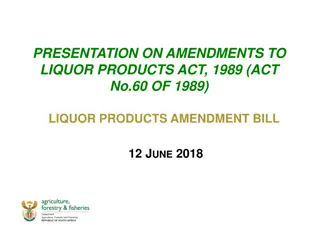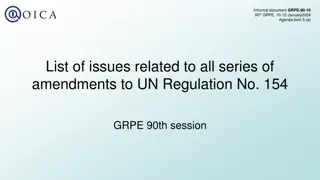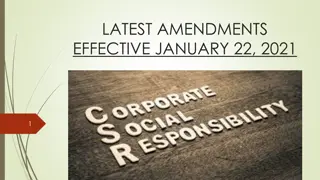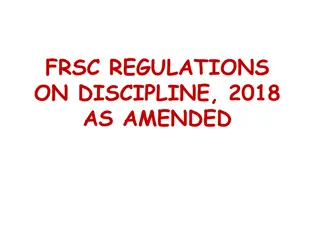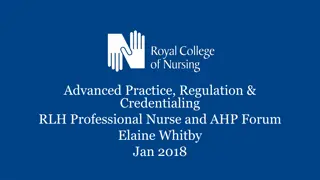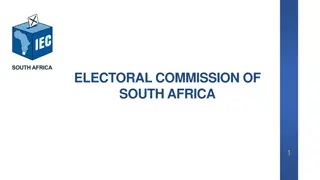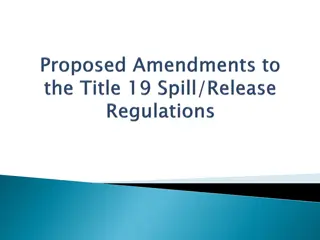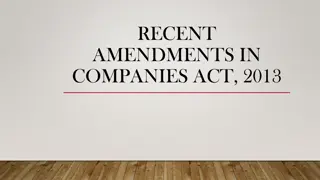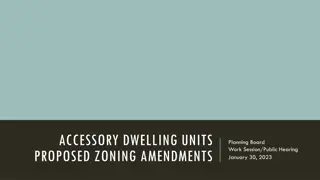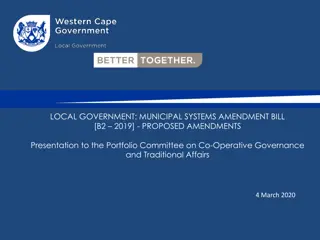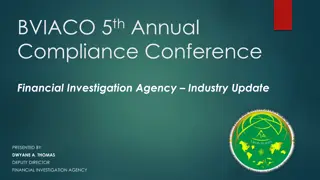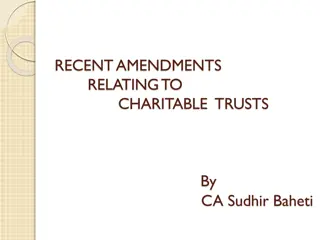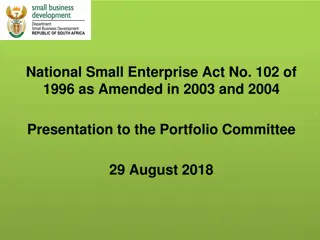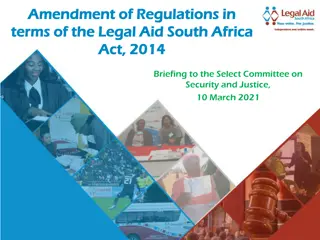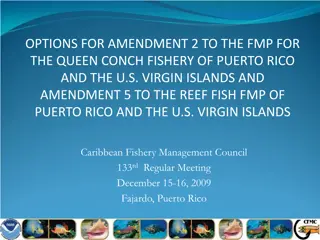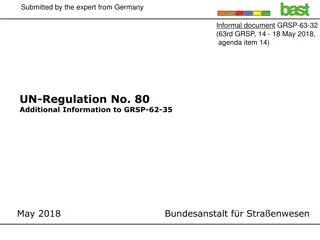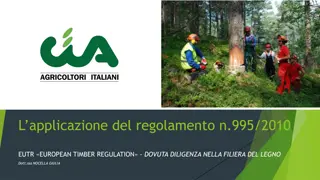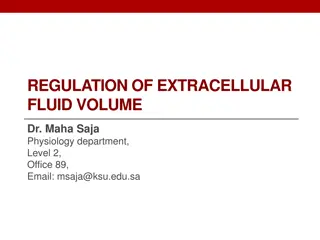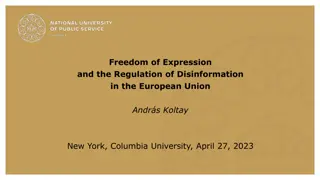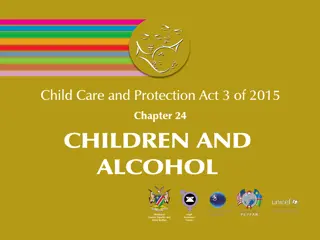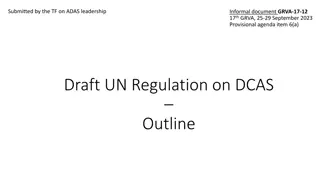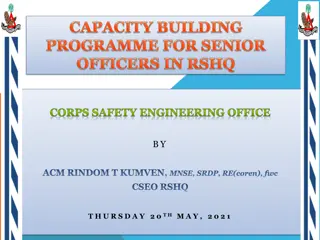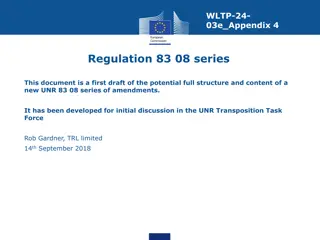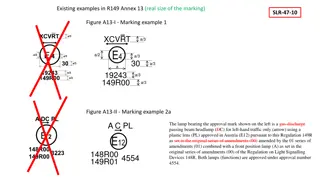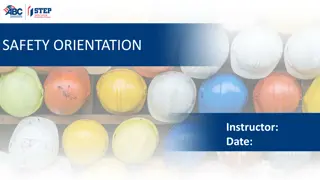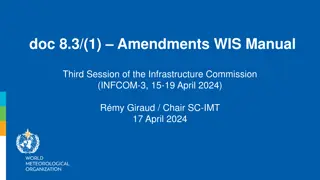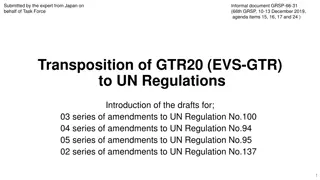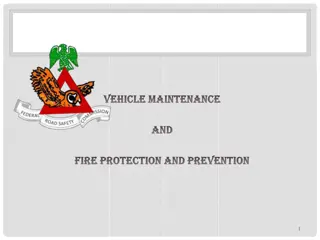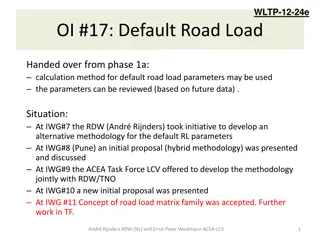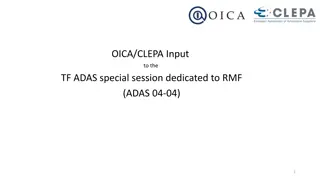Guidelines on UN Regulation Amendments for Vehicle Safety
The document discusses the adoption of Supplement 10 to the 03 series of amendments to UN Regulation R129 for vehicle safety. It focuses on clarifying requirements for belt routes to prevent misuse and ensure mutual recognition of Type Approvals. Technical amendments aim to enhance vehicle safety, environmental protection, and global harmonization. Supplements clarify test procedures and regulate new developments without changing stringency levels. Effective dates and application of Supplements are explained for approval procedures.
Download Presentation

Please find below an Image/Link to download the presentation.
The content on the website is provided AS IS for your information and personal use only. It may not be sold, licensed, or shared on other websites without obtaining consent from the author. Download presentation by click this link. If you encounter any issues during the download, it is possible that the publisher has removed the file from their server.
E N D
Presentation Transcript
Informal document GRSP-74-10 GRSP 74thsession, 4 8 December 2023 Transmitted by the expert from the Netherlands Agenda Item 12 Guidance supplement 10 to 03 series of UN R129 (ECE/TRANS/WP.29/2023/120) December 2023
Background At the 73rdmeeting of GRSP, supplement 10 to the 03 series of amendments to UN R129 was adopted and was presented and adopted at the 191stsession of WP.29 in November 2023 (ECE/TRANS/WP.29/2023/120) In this document, among other things, the existing requirement on one belt route is further explained in order to come to a better general understanding and interpretation among Type Approval Authorities with the aim to guarantee: - prevention of misuse by end-users of the product - mutual recognition of issued Type Approvals - a level playing field among manufacturers and Type Approval Authorities.
General guidelines on administrative/transitional provisions ECE/TRANS/WP.29/1044/Rev.3 B. Amendments to a UN Regulation 22. Technical amendments are aimed at adapting UN Regulations to technical l progress, improving vehicle safety and the protection of the environment, as well as achieving global harmonization. Subject to the decisions of the World Forum and its subsidiary body, they may result in new series of amendments in the case of a higher stringency of the requirements (e.g. more stringent limit values) or in Supplements in the case the level of stringency of the requirements is not changed or in the case of clarifications to the existing specifications aimed at avoiding misinterpretation.
General guidelines on administrative/transitional provisions B.2. Supplement 28. A Supplement is an amendment to a UN Regulation which is used for: (a) Clarification of test procedures not changing the level of stringency of the UN Regulation or imposing new requirements; or (b) Regulating new developments which have arisen after the adoption of a UN Regulation (i.e. extension of scope) not changing the level of stringency of the UN Regulation. 29. A Supplement does not entail a modification in the approval marking and shall not be used when it is necessary for Contracting Parties to differentiate the new approvals from the existing approvals.
General guidelines on administrative/transitional provisions 30. A Supplement becomes applicable as from the date of entry into force, after which tests according to the series of amendments to the UN Regulation, affected by that Supplement, need to take into account the Supplement in question. In the absence of any other date mentioned, Supplements become applicable for all procedures for approvals issued after the date of its entry into force, taking into account the transitional provisions, if any, of the series of amendments to which the Supplement refers and taking into account paragraphs 31.(a) and 31.(b) below. 31. In the case of Supplements that have entered into force: (a) Under Revision 2 of the 1958 Agreement (b) Under Revision 3 of the 1958 Agreement, a Supplement shall apply to new extensions of existing approvals. However, the Supplement may foresee that it will not affect existing approvals.
General guidelines on administrative/transitional provisions 32. Subject to paragraph 28, existing approvals do not need to be extended because of the entry into force of a new Supplement and Contracting Parties shall continue to recognize them in accordance with paragraph 26 above.
Why supplement was chosen for clarification of one belt route provision ? UN R129.03 3.2.2. The applicant shall indicate the kind of application: . or (i) Any combination of (a), (b), (c), (d), (g) and (h) as long as they fulfil paragraph 5.4.2.2., 6.1.2. and 6.1.3. provided there is only one belt route; or (j) Any combination of (c), (d), (e), (f), (g) and (h) as long as they fulfil paragraphs 5.4.2.2., 6.1.2. and 6.1.3. provided there is only one belt route and that the booster seat and booster cushion is not equipped with ISOFIX connectors => not a new requirement
Why supplement was chosen for clarification of one belt route provision ? supplement: - should not affect existing approvals - comes into effect right away, without transitional provisions - makes sure that new approvals to be issued will all take this requirement on board without different interpretations
What if new series was chosen for clarification of one belt route provision ? - New approvals could then still be issued using wrong interpretation until new series becomes mandatory (UN R129.04 => 1 September 2026)
What happens to existing approvals where different interpretation of the one belt route provision was followed ? - some known cases exist of approved ECRS in the past where different belt routes exist between integral and non-integral (booster seat) configurations and forward/rearward facing orientation within integral configurations - Responsibility of Granting Type Approval Authority (GTAA) - GTAA to verify that chance of misuse by end-user is very unlikely
What happens to existing approvals where different interpretation of the one belt route provision was followed ? - when extension to such approval is issued, the approval needs to be updated to the latest supplement level. - when either no new tests are performed or new tests do not affect existing belt route(s), extension to include the latest supplement is possible. - when existing approval is upgraded to UN R129.04, design will have to be brought in line with the strict interpretation of one belt route over the entire stature range according to footnote 2.



